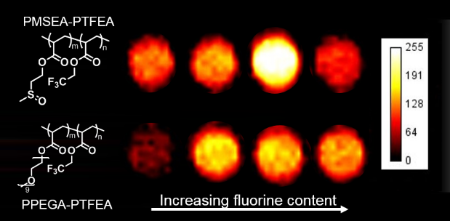Dr Changkui Fu has led a study of a new class of 19F MRI agent based on the hydrophilic monomer MSEA.
See: DOI: 10.1021/acs.macromol.8b01190
Enhanced Performance of Polymeric 19F MRI Contrast Agents through Incorporation of Highly Water-Soluble Monomer MSEA
19F magnetic resonance imaging (MRI) is a powerful noninvasive imaging technique that shows tremendous potential for the diagnosis and monitoring of human diseases. Fluorinated compounds are commonly used as 19F MRI contrast agents to develop “hot spot” imaging. To achieve high-resolution MR images, a high density of 19F nuclei is required in the contrast agents. However, because of the inherent hydrophobicity of fluorinated moieties, aggregation of 19F contrast agents with high fluorine content is often observed in aqueous solution, resulting in attenuated MR signal and low sensitivity, thus significantly limiting their further biological applications. Here we report the synthesis and characterization of a series of polymeric 19F MRI contrast agents with high fluorine content by copolymerizing the well-known fluorinated monomer 2,2,2-trifluoroethyl acrylate (TFEA) with a highly water-soluble monomer 2-(methylsulfinyl)ethyl acrylate (MSEA) using RAFT polymerization. We show that these polymeric contrast agents, although with high fluorine content, display remarkable imaging performance as evidenced by preferable relaxation properties and intense in vitro/in vivo MRI signals, demonstrating the huge potential for eventual clinical applications such as MRI-guided disease diagnosis and therapy.

